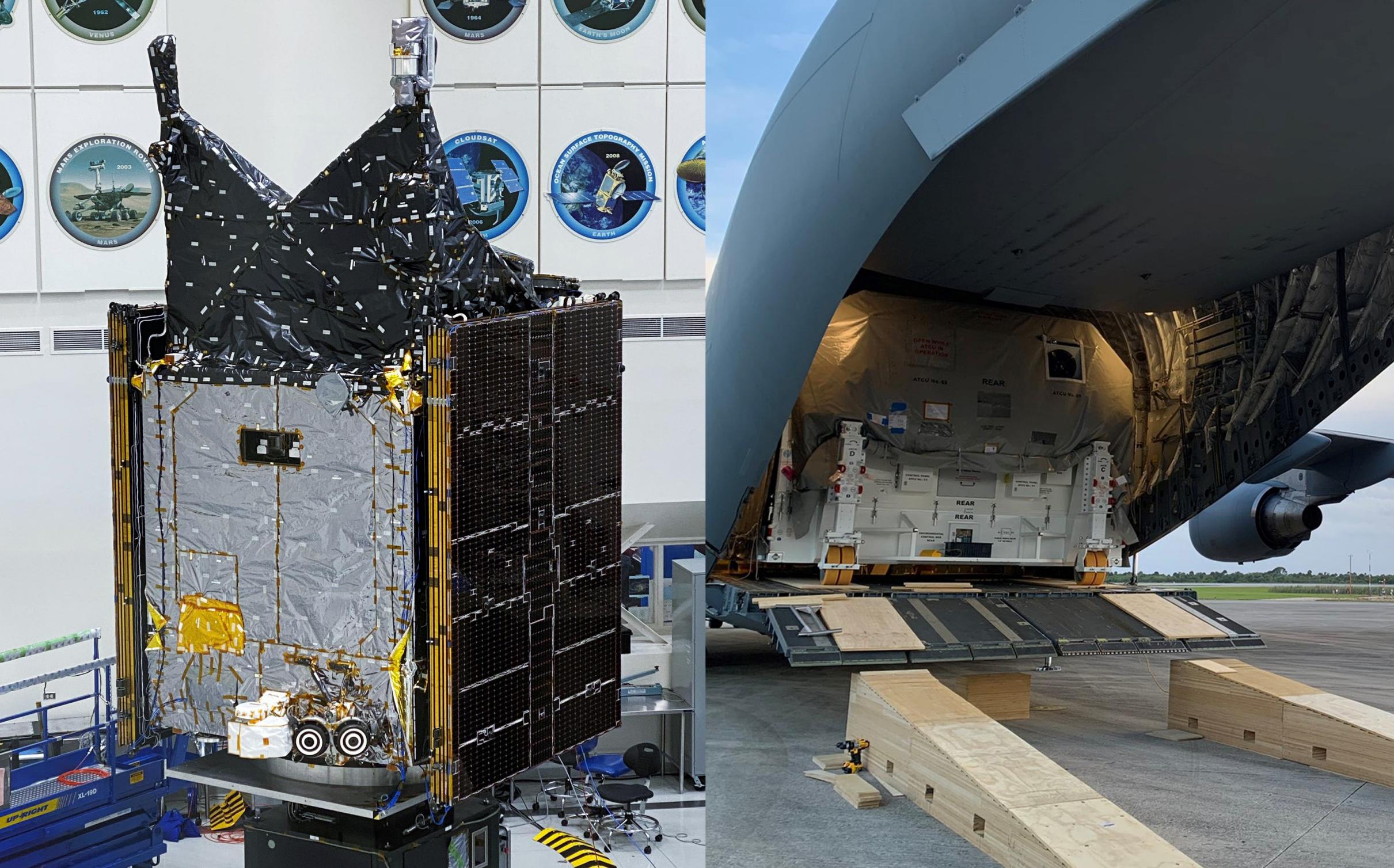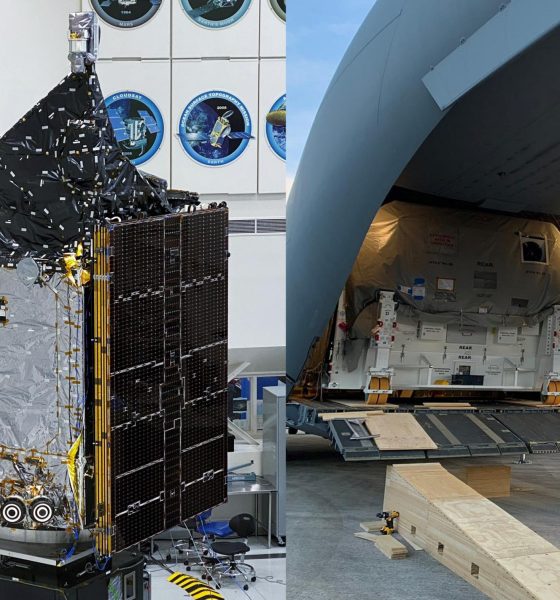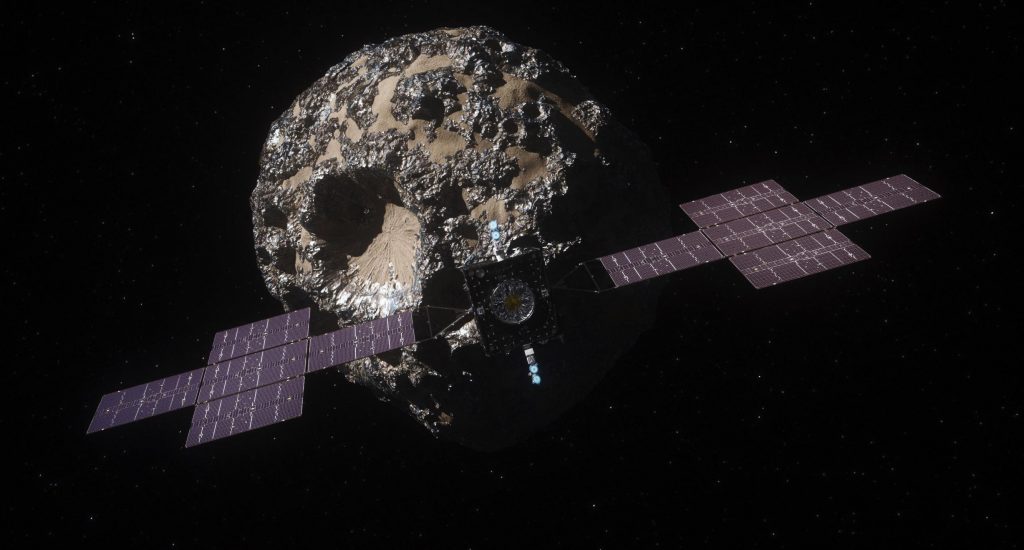

News
SpaceX Falcon Heavy payload arrives in Florida for the first time in years
For the first time in almost three years, a spacecraft meant to launch on SpaceX’s Falcon Heavy rocket has arrived in Cape Canaveral, Florida and begun to prepare for flight.
Known as Psyche, the scientific mission is designed to venture hundreds of millions of miles from Earth to explore a namesake asteroid that’s believed to be almost entirely metallic. Psyche will also mark NASA’s first operational use of Falcon Heavy, which offers performance far superior to other existing and soon-to-be-retired rockets and at a fraction of their cost.
However, even though Psyche is now the first payload (officially confirmed) to have arrived in Florida for a Falcon Heavy launch since May or June 2019, that doesn’t guarantee that it will be first to launch.

That uncertainty is the result of multiple chronically delayed US military payloads that were both supposed to launch on different Falcon Heavy rockets as early as late 2020. In June 2018, just four months after Falcon Heavy’s iconic launch debut, the US military purchased its first operational launch on the rocket. Known as AFSPC-52 and later renamed USSF-52 after the US government cobbled together a few loosely-related military groups and rebadged them as the “Space Force,” the mission was expected to launch as early as September 2020. In February 2019, the military announced that another Falcon Heavy rocket had been chosen to launch AFSPC-44 (USSF-44) as early as late 2020 or early 2021.
About a year ago, for unknown reasons, USSF-44 took USSF-52’s place as the US military’s first operational Falcon Heavy launch. Now, between three and four years after their initial launch targets, USSF-44 is scheduled to launch NET late June 2022 (a delay of ~18 months) and USSF-52 is set to follow as soon as October 2022 (a delay of ~25 months).
On April 29th, NASA’s Launch Service Program (LSP) revealed that the ~2600-kilogram (~5700 lb) Psyche spacecraft had completed the journey from the Jet Propulsion Laboratory’s (JPL) Pasadena, California assembly facilities to Kennedy Space Center, Florida. After several years of work spent designing, manufacturing, and assembling Psyche, the spacecraft ultimately arrived at on time, leaving it on track to launch on Falcon Heavy as early as August 1st, 2022.
At the moment, that makes Psyche’s launch far more likely to happen before USSF-44, which has repeatedly gotten within a few months of a purported launch target before the US military acknowledged additional delays. Like USSF-44, Psyche’s Falcon Heavy rocket – three boosters, an upper stage, and a fairing – will be entirely new. Due to the high performance required for each mission and the fact that both will be the first operational use of the rocket for NASA and the USSF, each brand-new Falcon Heavy center core will be intentionally expended.
If it launches more or less on time, USSF-44 will be SpaceX and Falcon Heavy’s first direct launch to geostationary orbit (GEO), requiring the rocket’s upper stage to survive a roughly six-hour-long coast and perform a lengthy orbit circularization burn around ~42,500 kilometers (~26,400 mi) above Earth’s surface. With a payload that weighs around four tons (~8800 lb), it’s little surprise that Falcon Heavy’s center core will be expended. Psyche, on the other hand, is headed into deep space on a trajectory that NASA’s own ELVPerf calculator – supplied with official performance data from SpaceX – says Falcon Heavy can launch more than four tons (~8800 lb) to while still recovering all three boosters. It’s unclear why NASA would need a 50-70% safety margin.
Regardless, the second half of 2022 could be quite the spectacle of Falcon Heavy launches after a more than three-year hiatus. On top of USSF-44, Psyche, and USSF-52, Falcon Heavy is tentatively scheduled to launch a ViaSat-3 communications satellite directly to GEO in Q3 2022 and, even more tentatively, the Space Force’s USSF-67 mission in November 2022.

Elon Musk
Elon Musk’s X will start using a Tesla-like software update strategy
The initiative seems designed to accelerate updates to the social media platform, while maintaining maximum transparency.

Elon Musk’s social media platform X will adopt a Tesla-esque approach to software updates for its algorithm.
The initiative seems designed to accelerate updates to the social media platform, while maintaining maximum transparency.
X’s updates to its updates
As per Musk in a post on X, the social media company will be making a new algorithm to determine what organic and advertising posts are recommended to users. These updates would then be repeated every four weeks.
“We will make the new 𝕏 algorithm, including all code used to determine what organic and advertising posts are recommended to users, open source in 7 days. This will be repeated every 4 weeks, with comprehensive developer notes, to help you understand what changed,” Musk wrote in his post.
The initiative somewhat mirrors Tesla’s over-the-air update model, where vehicle software is regularly refined and pushed to users with detailed release notes. This should allow users to better understand the details of X’s every update and foster a healthy feedback loop for the social media platform.
xAI and X
X, formerly Twitter, has been acquired by Elon Musk’s artificial intelligence startup, xAI last year. Since then, xAI has seen a rapid rise in valuation. Following the company’s the company’s upsized $20 billion Series E funding round, estimates now suggest that xAI is worth tens about $230 to $235 billion. That’s several times larger than Tesla when Elon Musk received his controversial 2018 CEO Performance Award.
As per xAI, the Series E funding round attracted a diverse group of investors, including Valor Equity Partners, Stepstone Group, Fidelity Management & Research Company, Qatar Investment Authority, MGX, and Baron Capital Group, among others. Strategic partners NVIDIA and Cisco Investments also continued support for building the world’s largest GPU clusters.
News
Tesla FSD Supervised wins MotorTrend’s Best Driver Assistance Award
The decision marks a notable reversal for the publication from prior years, with judges citing major real-world improvements that pushed Tesla’s latest FSD software ahead of every competing ADAS system.

Tesla’s Full Self-Driving (Supervised) system has been named the best driver-assistance technology on the market, earning top honors at the 2026 MotorTrend Best Tech Awards.
The decision marks a notable reversal for the publication from prior years, with judges citing major real-world improvements that pushed Tesla’s latest FSD software ahead of every competing ADAS system. And it wasn’t even close.
MotorTrend reverses course
MotorTrend awarded Tesla FSD (Supervised) its 2026 Best Tech Driver Assistance title after extensive testing of the latest v14 software. The publication acknowledged that it had previously criticized earlier versions of FSD for erratic behavior and near-miss incidents, ultimately favoring rivals such as GM’s Super Cruise in earlier evaluations.
According to MotorTrend, the newest iteration of FSD resolved many of those shortcomings. Testers said v14 showed far smoother behavior in complex urban scenarios, including unprotected left turns, traffic circles, emergency vehicles, and dense city streets. While the system still requires constant driver supervision, judges concluded that no other advanced driver-assistance system currently matches its breadth of capability.
Unlike rival systems that rely on combinations of cameras, radar, lidar, and mapped highways, Tesla’s FSD operates using a camera-only approach and is capable of driving on city streets, rural roads, and freeways. MotorTrend stated that pure utility, the ability to handle nearly all road types, ultimately separated FSD from competitors like Ford BlueCruise, GM Super Cruise, and BMW’s Highway Assistant.
High cost and high capability
MotorTrend also addressed FSD’s pricing, which remains significantly higher than rival systems. Tesla currently charges $8,000 for a one-time purchase or $99 per month for a subscription, compared with far lower upfront and subscription costs from other automakers. The publication noted that the premium is justified given FSD’s unmatched scope and continuous software evolution.
Safety remained a central focus of the evaluation. While testers reported collision-free operation over thousands of miles, they noted ongoing concerns around FSD’s configurable driving modes, including options that allow aggressive driving and speeds beyond posted limits. MotorTrend emphasized that, like all Level 2 systems, FSD still depends on a fully attentive human driver at all times.
Despite those caveats, the publication concluded that Tesla’s rapid software progress fundamentally reshaped the competitive landscape. For drivers seeking the most capable hands-on driver-assistance system available today, MotorTrend concluded Tesla FSD (Supervised) now stands alone at the top.
News
Elon Musk’s Grokipedia surges to 5.6M articles, almost 79% of English Wikipedia
The explosive growth marks a major milestone for the AI-powered online encyclopedia, which was launched by Elon Musk’s xAI just months ago.

Elon Musk’s Grokipedia has grown to an impressive 5,615,201 articles as of today, closing in on 79% of the English Wikipedia’s current total of 7,119,376 articles.
The explosive growth marks a major milestone for the AI-powered online encyclopedia, which was launched by Elon Musk’s xAI just months ago. Needless to say, it would only be a matter of time before Grokipedia exceeds English Wikipedia in sheer volume.
Grokipedia’s rapid growth
xAI’s vision for Grokipedia emphasizes neutrality, while Grok’s reasoning capabilities allow for fast drafting and fact-checking. When Elon Musk announced the initiative in late September 2025, he noted that Grokipedia would be an improvement to Wikipedia because it would be designed to avoid bias.
At the time, Musk noted that Grokipedia “is a necessary step towards the xAI goal of understanding the Universe.”
Grokipedia was launched in late October, and while xAI was careful to list it only as Version 0.1 at the time, the online encyclopedia immediately earned praise. Wikipedia co-founder Larry Sanger highlighted the project’s innovative approach, noting how it leverages AI to fill knowledge gaps and enable rapid updates. Netizens also observed how Grokipedia tends to present articles in a more objective manner compared to Wikipedia, which is edited by humans.
Elon Musk’s ambitious plans
With 5,615,201 total articles, Grokipedia has now grown to almost 79% of English Wikipedia’s article base. This is incredibly quick, though Grokipedia remains text-only for now. xAI, for its part, has now updated the online encyclopedia’s iteration to v0.2.
Elon Musk has shared bold ideas for Grokipedia, including sending a record of the entire knowledge base to space as part of xAI’s mission to preserve and expand human understanding. At some point, Musk stated that Grokipedia will be renamed to Encyclopedia Galactica, and it will be sent to the cosmos.
“When Grokipedia is good enough (long way to go), we will change the name to Encyclopedia Galactica. It will be an open source distillation of all knowledge, including audio, images and video. Join xAI to help build the sci-fi version of the Library of Alexandria!” Musk wrote, adding in a later post that “Copies will be etched in stone and sent to the Moon, Mars and beyond. This time, it will not be lost.”








